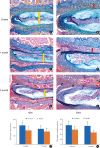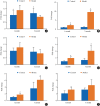Accumulated Spinal Axial Biomechanical Loading Induces Degeneration in Intervertebral Disc of Mice Lumbar Spine
- PMID: 29436145
- PMCID: PMC6594506
- DOI: 10.1111/os.12365
Accumulated Spinal Axial Biomechanical Loading Induces Degeneration in Intervertebral Disc of Mice Lumbar Spine
Abstract
Objective: To investigate the effect of accumulated spinal axial biomechanical loading on mice lumbar disc and the feasibility of applying this method to establish a mice intervertebral disc degeneration model using a custom-made hot plate cage. In previous studies, we observed that the motion pattern of mice was greatly similar to that of humans when they were standing and jumping on their lower limbs. There is little data to demonstrate whether or not accumulated spinal axial biomechanical loading could induce intervertebral disc degeneration in vivo.
Methods: Twenty-four 0-week-old mice were randomly divided into model 1-month and 3-month groups, and control 1-month and 3-month groups (n = 6 per group). The model groups was transferred into the custom-made hot plate cage three times per day for modeling. The control group was kept in a regular cage. The intervertebral disc samples of the L3 -L5 were harvested for histologic, molecular, and immunohistochemical studies after modeling for 1 and 3 months.
Results: Accumulated spinal axial biomechanical loading affects the histologic, molecular, and immunohistochemical changes of mice L3- L5 intervertebral discs. Decreased height of disc and endplate, fissures of annulus fibrosus, and ossification of cartilage endplate were found in morphological studies. Immunohistochemical studies of the protein level showed a similar expression of type II collagen at 1 month, but a slightly decreased expression at 3 months, and an increased expression level of type X collagen and matrix metalloproteinase 13 (MMP13). Molecular studies showed that ColIIa1 and aggrecan mRNA expression levels were slightly increased at 1 month (P > 0.05), but then decreased slightly (P > 0.05). ColXa1, ADAMTS-5, and MMP-13 expression levels werer increased both at 1 and 3 months (P < 0.05). In addition, increased expression of Runx2 was observed.
Conclusion: Accumulated spinal axial loading provided by a custom-made hot plate accelerated mice lumbar disc and especially endplate degeneration. However, this method requires further development to establish a lumbar disc degeneration model.
Keywords: Biomechanical loading; Degeneration; Endplate; Intervertebral disc; Lumbar; Model.
© 2018 Chinese Orthopaedic Association and John Wiley & Sons Australia, Ltd.
Figures





Similar articles
-
Prolonged upright posture induces degenerative changes in intervertebral discs in rat lumbar spine.Spine (Phila Pa 1976). 2008 Sep 1;33(19):2052-8. doi: 10.1097/BRS.0b013e318183f949. Spine (Phila Pa 1976). 2008. PMID: 18758360
-
Mechanical destabilization induced by controlled annular incision of the intervertebral disc dysregulates metalloproteinase expression and induces disc degeneration.Spine (Phila Pa 1976). 2012 Jan 1;37(1):18-25. doi: 10.1097/BRS.0b013e31820cd8d5. Spine (Phila Pa 1976). 2012. PMID: 22179320
-
Effects of controlled dynamic disc distraction on degenerated intervertebral discs: an in vivo study on the rabbit lumbar spine model.Spine (Phila Pa 1976). 2005 Jan 15;30(2):181-7. doi: 10.1097/01.brs.0000150487.17562.b1. Spine (Phila Pa 1976). 2005. PMID: 15644753
-
Recent advances in analytical modeling of lumbar disc degeneration.Spine (Phila Pa 1976). 2004 Dec 1;29(23):2733-41. doi: 10.1097/01.brs.0000146471.59052.e6. Spine (Phila Pa 1976). 2004. PMID: 15564922 Review.
-
Mechanical Aspects of Intervertebral Disc Injury and Implications on Biomechanics.Spine (Phila Pa 1976). 2020 Apr 15;45(8):E457-E464. doi: 10.1097/BRS.0000000000003291. Spine (Phila Pa 1976). 2020. PMID: 31651681 Review.
Cited by
-
Constant compression decreases vascular bud and VEGFA expression in a rabbit vertebral endplate ex vivo culture model.PLoS One. 2020 Jun 25;15(6):e0234747. doi: 10.1371/journal.pone.0234747. eCollection 2020. PLoS One. 2020. PMID: 32584845 Free PMC article.
-
Identification of preoperative radiological risk factors for reoperation following percutaneous endoscopic lumbar decompression to treat degenerative lumbar spinal stenosis.Front Surg. 2023 Jan 6;9:1054760. doi: 10.3389/fsurg.2022.1054760. eCollection 2022. Front Surg. 2023. PMID: 36684204 Free PMC article.
-
In vivo Mouse Intervertebral Disc Degeneration Models and Their Utility as Translational Models of Clinical Discogenic Back Pain: A Comparative Review.Front Pain Res (Lausanne). 2022 Jun 22;3:894651. doi: 10.3389/fpain.2022.894651. eCollection 2022. Front Pain Res (Lausanne). 2022. PMID: 35812017 Free PMC article. Review.
-
Prediction of a Potential Mechanism of Intervertebral Disc Degeneration Based on a Novel Competitive Endogenous RNA Network.Biomed Res Int. 2021 Jun 30;2021:6618834. doi: 10.1155/2021/6618834. eCollection 2021. Biomed Res Int. 2021. PMID: 34307661 Free PMC article.
-
Lang-chuang-ding restores bone homeostasis in systemic lupus erythematosus associated osteoporosis by targeting NF-κB signaling: a network pharmacology and experimental study.Front Endocrinol (Lausanne). 2025 Jul 30;16:1639261. doi: 10.3389/fendo.2025.1639261. eCollection 2025. Front Endocrinol (Lausanne). 2025. PMID: 40810073 Free PMC article.
References
-
- Walsh AJ, Lotz JC. Biological response of the intervertebral disc to dynamic loading . J Biomech, 2004, 37: 329–337. - PubMed
-
- Hsieh AH, Lotz JC. Prolonged spinal loading induces matrix metalloproteinase‐2 activation in intervertebral discs . Spine (Phila Pa 1976), 2003, 28: 1781–1788. - PubMed
-
- Le Maitre CL, Binch AL, Thorpe A, Hughes SP. Degeneration of the intervertebral disc with new approaches for treating low back pain . J Neurosurg Sci, 2015, 59: 47–61. - PubMed
-
- Kimura S, Steinbach GC, Watenpaugh DE, Hargens AR. Lumbar spine disc height and curvature responses to an axial load generated by a compression device compatible with magnetic resonance imaging . Spine (Phila Pa 1976), 2001, 26: 2596–2600. - PubMed
MeSH terms
Substances
LinkOut - more resources
Full Text Sources
Other Literature Sources

